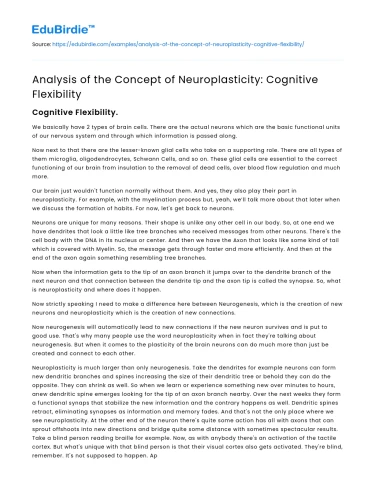Cognitive Flexibility.
We basically have 2 types of brain cells. There are the actual neurons which are the basic functional units of our nervous system and through which information is passed along.
Now next to that there are the lesser-known glial cells who take on a supporting role. There are all types of them microglia, oligodendrocytes, Schwann Cells, and so on. These glial cells are essential to the correct functioning of our brain from insulation to the removal of dead cells, over blood flow regulation and much more.
Save your time!
We can take care of your essay
- Proper editing and formatting
- Free revision, title page, and bibliography
- Flexible prices and money-back guarantee
Our brain just wouldn't function normally without them. And yes, they also play their part in neuroplasticity. For example, with the myelination process but, yeah, we’ll talk more about that later when we discuss the formation of habits. For now, let's get back to neurons.
Neurons are unique for many reasons. Their shape is unlike any other cell in our body. So, at one end we have dendrites that look a little like tree branches who received messages from other neurons. There's the cell body with the DNA in its nucleus or center. And then we have the Axon that looks like some kind of tail which is covered with Myelin. So, the message gets through faster and more efficiently. And then at the end of the axon again something resembling tree branches.
Now when the information gets to the tip of an axon branch it jumps over to the dendrite branch of the next neuron and that connection between the dendrite tip and the axon tip is called the synapse. So, what is neuroplasticity and where does it happen.
Now strictly speaking I need to make a difference here between Neurogenesis, which is the creation of new neurons and neuroplasticity which is the creation of new connections.
Now neurogenesis will automatically lead to new connections if the new neuron survives and is put to good use. That's why many people use the word neuroplasticity when in fact they're talking about neurogenesis. But when it comes to the plasticity of the brain neurons can do much more than just be created and connect to each other.
Neuroplasticity is much larger than only neurogenesis. Take the dendrites for example neurons can form new dendritic branches and spines increasing the size of their dendritic tree or behold they can do the opposite. They can shrink as well. So when we learn or experience something new over minutes to hours, anew dendritic spine emerges looking for the tip of an axon branch nearby. Over the next weeks they form a functional synaps that stabilize the new information and the contrary happens as well. Dendritic spines retract, eliminating synapses as information and memory fades. And that's not the only place where we see neuroplasticity. At the other end of the neuron there's quite some action has all with axons that can sprout offshoots into new directions and bridge quite some distance with sometimes spectacular results. Take a blind person reading braille for example. Now, as with anybody there's an activation of the tactile cortex. But what's unique with that blind person is that their visual cortex also gets activated. They're blind, remember. It's not supposed to happen. Apparently axons offshoots have found their way to the visual cortex as well. But that's really surprising is the sensory cortex and the visual cortex are quite far apart. There's even a case where a woman who was blind by birth had a stroke in her visual cortex after which she was unable to read braille anymore. And the contrary is true as well. Deaf people learning sign language or growing axons into their auditory cortex. It's as if the neurons know where there is some unused real estate within the brain and then the Axons just go there and squat it. Injuries to our nervous system can remap in a similar way. For the sake of argument let's say a person had a stroke and some damage occurred to the part of the cortex that receives tactile information from the hand. Now the hand has no damage. Neither do the nerve cells in the hand. It's within the brain that the connection got lost. But the hand is fine. It's just not communicating anymore. So the person loses sensation in her hands. Well in the following months and years axons from these receptors can sprout off and find a new way to re-establish communication using a bypass through neighboring parts of the cortex. This would lead to a partial return of the sense of touch for the person who suffered a stroke. But this remapping happens also without an injury having to occur. Take musicians for example who have a larger auditory cortex than non-musicians or London cab drivers who know their city by heart and have a larger hippocampus. Or more precisely The back part of the hippocampus which plays a role in memory and spatial maps. Or spent three months learning how to juggle and there is an expansion of the part of the cortex dealing with visual processing of movement. In other words what we do, our experiences, bring on changes in the number and strength of Synapses, dendrite branches and axons. Everything we do, or stop doing, has an impact in our brain. It continuously changes, evolves, adapts to answer to our immediate challenges in our everyday life. It is our immediate environment and how we interact with it, that ends up shaping our brain. In other words the way we interact with our environment is the key to rewiring our brain.






 Stuck on your essay?
Stuck on your essay?

